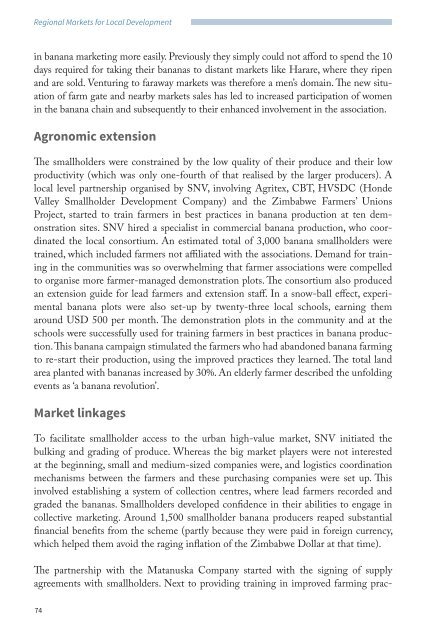Regional Markets
56ec00c44c641_local-markets-book_complete_LR
56ec00c44c641_local-markets-book_complete_LR
Create successful ePaper yourself
Turn your PDF publications into a flip-book with our unique Google optimized e-Paper software.
<strong>Regional</strong> <strong>Markets</strong> for Local Development<br />
in banana marketing more easily. Previously they simply could not afford to spend the 10<br />
days required for taking their bananas to distant markets like Harare, where they ripen<br />
and are sold. Venturing to faraway markets was therefore a men’s domain. The new situation<br />
of farm gate and nearby markets sales has led to increased participation of women<br />
in the banana chain and subsequently to their enhanced involvement in the association.<br />
Agronomic extension<br />
The smallholders were constrained by the low quality of their produce and their low<br />
productivity (which was only one-fourth of that realised by the larger producers). A<br />
local level partnership organised by SNV, involving Agritex, CBT, HVSDC (Honde<br />
Valley Smallholder Development Company) and the Zimbabwe Farmers’ Unions<br />
Project, started to train farmers in best practices in banana production at ten demonstration<br />
sites. SNV hired a specialist in commercial banana production, who coordinated<br />
the local consortium. An estimated total of 3,000 banana smallholders were<br />
trained, which included farmers not affiliated with the associations. Demand for training<br />
in the communities was so overwhelming that farmer associations were compelled<br />
to organise more farmer-managed demonstration plots. The consortium also produced<br />
an extension guide for lead farmers and extension staff. In a snow-ball effect, experimental<br />
banana plots were also set-up by twenty-three local schools, earning them<br />
around USD 500 per month. The demonstration plots in the community and at the<br />
schools were successfully used for training farmers in best practices in banana production.<br />
This banana campaign stimulated the farmers who had abandoned banana farming<br />
to re-start their production, using the improved practices they learned. The total land<br />
area planted with bananas increased by 30%. An elderly farmer described the unfolding<br />
events as ‘a banana revolution’.<br />
Market linkages<br />
To facilitate smallholder access to the urban high-value market, SNV initiated the<br />
bulking and grading of produce. Whereas the big market players were not interested<br />
at the beginning, small and medium-sized companies were, and logistics coordination<br />
mechanisms between the farmers and these purchasing companies were set up. This<br />
involved establishing a system of collection centres, where lead farmers recorded and<br />
graded the bananas. Smallholders developed confidence in their abilities to engage in<br />
collective marketing. Around 1,500 smallholder banana producers reaped substantial<br />
financial benefits from the scheme (partly because they were paid in foreign currency,<br />
which helped them avoid the raging inflation of the Zimbabwe Dollar at that time).<br />
The partnership with the Matanuska Company started with the signing of supply<br />
agreements with smallholders. Next to providing training in improved farming prac-<br />
74


